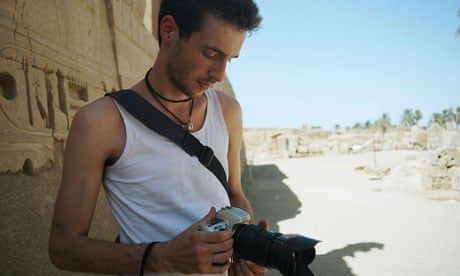Tom Hurndall was a peace activist and an aspiring photojournalist. His photographs, alongside his journals, bear witness to the often terrible, sometimes uplifting, events he saw and experienced while living among families in Iraq, in a refugee camp in Jordan, and in the Gaza Strip. It was there on 11 April 2003 that he was shot in the head by an Israeli soldier while attempting to rescue a child who had been pinned down by gunfire. He died nine months later in hospital in London. He was 22.
It is difficult, then, to look dispassionately at the photographs in The Only House Left Standing: The Middle East Journals of Tom Hurndall, which is published by Trolley Books this week. They are a mixture of reportage and citizen journalism of the most intense kind; a visual record of struggle and conflict left by someone who comes across as extraordinarily committed and fearless. As his writings show, though, Hurndall grappled with his fear every day. He travelled to Baghdad in 2003, one of a group of "human shields" who arrived just before the invasion by American and British troops, determined to protest the war in the most direct and dangerous way. In a series of articles emailed to Manchester Metropolitan University's student magazine, Pulp, he wrote honestly and without self-pity about his constant doubts and creeping fears. One sentence stands out: "When a man must lie to himself to do what he knows he should, that is when you know he is terrified."
It is hard to equate these words, this kind of self-knowledge, with the handsome, short-haired, unshaven young man who smiles out from the first photograph in the book, cigarette in hand. He looks like a student about to begin a gap year, having just landed in some faraway country where adventure awaits. Like the emails and articles that punctuate the book, the photographs grow in intensity as his journey becomes ever more difficult, ever more dangerous.
He took photographs inside a power station in Baghdad, on the streets of Amman, and in the Al-Rweished refugee camp just five kilometres from the Iraq border. He had an eye for light and shadow, for the snatched portrait, and for capturing a mood, whether joyful or sombre. By April 2003, he had arrived in Israel and, as the veteran Middle East correspondent Robert Fisk writes in his foreword, was heading "inexorably towards Gaza where he was confronted by the massive tragedy of the Palestinians".
In Jerusalem, on 3 April, he wrote of the death of Rachel Corrie, who had been crushed to death by an Israeli defence force bulldozer while acting as a human shield near the Rafah refugee camp. "I wonder how few or many people heard it on the news and just counted it as another death, just another number … "
In the final section of the book, Rafah, Gaza, 06-11 April 2003, there is a series of Hurndall's photographs from the frontline of the protests against the Israeli tanks and D-9 bulldozers demolishing Palestinian houses. They are both dramatic and oddly intimate, a view from the ground of dirt and destruction, chaos and violence as well as the strange sense of calm determination that comes from the civilians in bright orange jackets who line up before these massive and intimidating machines.
In his journal, Hurndall describes that day's events: "It was strange. As we approached, and the guns were firing, it sent shivers down my spine, but nothing more than that." The entry ends: "Any one of us could be watched through a sniper's sights at this moment. The certainty is that they are watching, and it is on the decision of any one Israeli soldier or settler that my life depends …"
The last picture that Hurndall took was a black-and-white shot of a street in Rafah at 1.30pm on 11 April 2003: a burnt-out car in the foreground, two children in the middle distance. The final picture in the book was taken by someone else. It shows him being carried unconscious by two local youths, both of whom are shouting for help. To the left, another youth is clutching his head in horror and despair. What looks like a camera bag is hanging from Hurndall's waist. Beneath it, the dusty street is stained with blood.
In the frantic few minutes before this picture was taken, according to a first-hand account by the local co-ordinator of the International Solidarity Movement, Hurndall had rescued a young boy "trapped under fire behind a sand mound". Having carried the boy to safety, he went back to the same spot to rescue a young girl and, "as he was attempting to carry her, he got hit in the forehead by an Israeli sniper bullet".
Hurndall's journals, as Fisk puts it, "show a remarkable man of remarkable principle". His photographs, too, are testament to the strength of his commitment to the cause of non-violent protest, and to his courage. He caught the world around him in all its uncertainty and, as it grew more dangerous and threatening, his eye grew keener. The images he produced became, by turns, more unflinching and reflective. They tell their own story of a brief life lived to the full.
Now see this
To celebrate the publication of a photobook called Lyrics of Love, the first solo show of the work of the great Lithuanian photographer, Algirdas Šeškus, runs at London's White Space Gallery from 1-10 March. The exhibition brings together some of his iconic images from the 1970s. His style is impressionistic and centres on the everyday in keeping with his idea that photography should remain true to its origins. Lyrics of Love is a break with his more recognisable work, and presents often-romantic glimpses of a country that is part-real, part a product of his rich, visual imagination. A long overdue acknowledgment of a photographic pioneer.

Comments (…)
Sign in or create your Guardian account to join the discussion